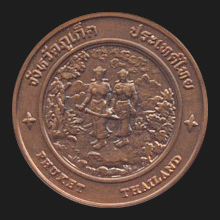|
Phuket (ภูเก็ต)
Province (map) and island (map) in the Andaman Sea facing the west coast of the southern Thai peninsula.
The name Phuket is derived from the Malay word bukit (บูกิ๊ต), meaning ‘hill’. Additionally, in Tamil, Phuket is said to mean ‘Crystal Mountain’, where the syllable ket (เก็ต) is a local variant of the Thai word
kaew (แก้ว), meaning ‘crystal’. Earlier, the island was known as
Thalang and
Jung Ceylon. Its capital city of the same name has a population of about 50,000 and is located 862 kms from
Bangkok. With approximately 810 kms² it is the largest island
of the country and connected to the mainland and the province of Phang Nga by a bridge to the North.
Formerly Phuket was on one of the major trading routes between India and
China,
and was frequently mentioned in foreign ship logs of European traders. It thus
derived prosperity from international trade, especially with regards to the
production and trade of tin, for which the French in 1685 had gained a monopoly
under king
Narai. However, in 1688 the French were
expelled from Siam, following the revolt of
Ayutthaya. On 10 April 1689, the French led an expedition to
capture the island of Phuket in an attempt to regain the monopoly and enforce some sort of French control in Siam. Nevertheless, the French occupation
led nowhere and in January 1690, they left again. Around February 1785, the
Burmese were preparing to attack the island with an army of about 3,000 men, but
Francis Light, a captain with the British East India Company passing by the
island, sent word to the local administration that he had observed Burmese
forces getting organized to invade. Thanks to this early warning,
the sisters
Chan and
Muk (fig.),
later known as the
Phuket Heroines
(fig.),
were able to repel the invasion, after a month-long siege. When in the
beginning of the 20th century tin supplies on the island declined and the tin
mines diminished, Phuket switched to the production of
rubber. Phuket is now a popular holiday destination with many beaches and
places of interest,
and derives much of its present income from tourism,
with Patong Beach (fig., vdo), arguably being the most famous beach on the island.
Patong
is the main tourist resort on the island and its town is the center of Phuket's nightlife (fig.) and shopping (fig.). Additionally, Phuket is famous for its annual
Vegetarian Festival (fig.).
Other places of interest include the Big
Buddha (fig.), Lion Cape Beach (fig.),
Laem Phromthep (fig.) and Promthep Clock Tower (fig.), etc.
On 26 December 2004, Phuket was affected by a
tsunami
that hit Thailand's Andaman coast line, killing around eight thousand people, of
which reportedly about 250 in this province, many of them foreign holidaymakers
celebrating Christmas, but also Thais and illegal Burmese construction workers,
whose death was often unreported. Worldwide over 220,000 were killed
or went missing. The province has three
amphur.
See also
Phuket data file.
回






|

